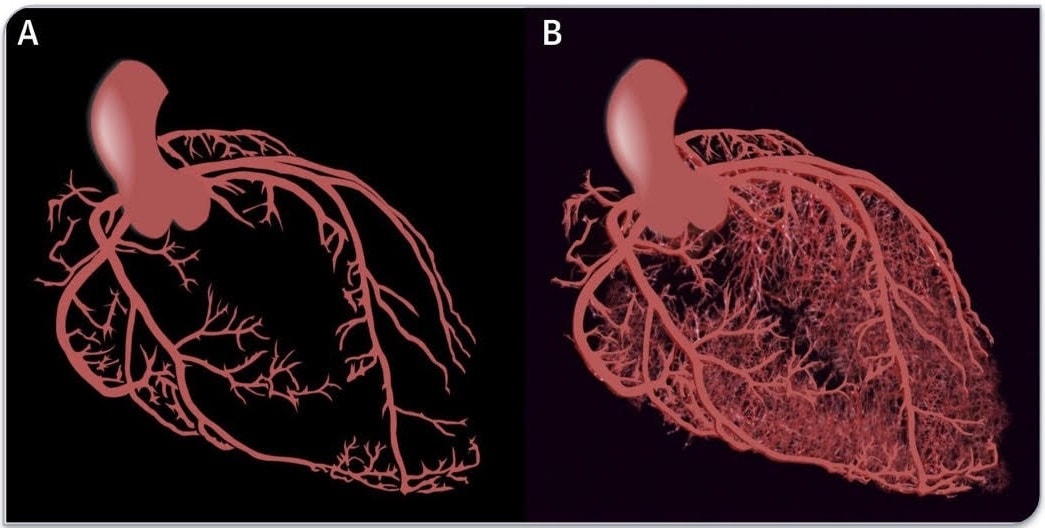NON-OBSTRUCTIVE CORONARY ARTERY DISEASE: AN EMERGING CONDITION AMONG WOMEN
 The figure A is a patient with ischemic, non-obstructive coronary artery disease. Whereas the major blood vessels supplying the heart muscle are fine, the small microvessels are not present or are dysfunctional do not supply adequate blood to the working heart muscle. This occurs more than twice as often in women than men. In Figure B, it illustrates a healthy heart with adequate blood flow through the major coronary arteries as well as the small blood vessels.
The figure A is a patient with ischemic, non-obstructive coronary artery disease. Whereas the major blood vessels supplying the heart muscle are fine, the small microvessels are not present or are dysfunctional do not supply adequate blood to the working heart muscle. This occurs more than twice as often in women than men. In Figure B, it illustrates a healthy heart with adequate blood flow through the major coronary arteries as well as the small blood vessels.
May is the month we honor our mothers with Mothers’ Day. If it weren’t for our mothers none of us would be here.
It is important to celebrate Mother’s Day and bring awareness to an emerging conditions that is affecting middle aged and older women. It is called ischemic, non-obstructive coronary artery disease or INOCA. Although the name and diagnosis may be challenging to understand, the name describes the condition.
Ischemia is a term for reduced and inadequate blood flow. The non-obstructive description reveals that the lack of blood flow is not due to plaque deposition or any narrowing of the main blood vessels that supply the heart muscle. During routine imaging through angiography, it is usually apparent that the main coronary arteries are not occluded.
Thus the name and diagnosis of ischemic, non-obstructive coronary artery disease. See illustration above on the left showing no major blood flow through the small arteries supplying the heart.This condition affects women more than twice the rate at which it affects men.
Different Symptoms in Men and Women
Although patients usually present with chest pain or discomfort, many times, women do not exhibit the same symptoms as men with coronary artery disease. Among patients hospitalized with myocardial infarction, or heart attack, women are more likely to present without chest pain and this is linked with higher mortality versus men of the same age. The proportion presenting without pain in the chest, arm, neck or jaw was higher for women than men (42.0% vs. 30.7%). This is concerning since there is not always obvious symptoms of disease. Death can occur is as many as 2% within 30 days of those patients with underlying INOCA.
Ischemic non-obstructive coronary artery disease is now considered a microvascular disease or a disease of the small blood vessels that supply the heart muscle with blood.
The term endothelial dysfunction is used. Endothelial dysfunction is when the endothelial cells (cells that line every blood vessel in the body) cannot make sufficient nitric oxide to deliver oxygen and nutrients to individual cells. As a result the cells of the heart muscle do not get sufficient blood flow and oxygen to support the metabolic activity of the heart.
This is called ischemia. Lack of oxygen and blood flow to the heart for an extended period of time can cause serious damage and death. Since standard ischemia detection tests and coronary angiograms are not suitable to diagnose coronary vascular dysfunction, INOCA is often overlooked in current cardiology practices.
Signs of Ischemia
So what should you look for and pay attention to?
The main symptom caused by coronary vascular dysfunction is angina or chest pain/discomfort. Dyspnea or shortness of breath, fatigue or palpitations may occur in addition to, or instead of, angina. Angina that is caused by INOCA may be very difficult to distinguish from ‘classical’ angina due to obstructive heart disease as both are mainly exercise-related.
However, coronary microvascular dysfunction is more likely if chest pain persists for several minutes to hours after exercise. In addition, patients with vascular dysfunction often experience loss of energy and extreme tiredness that may fluctuate over time (days/weeks). This often affects their ability to work, which is a serious problem in this relatively young population. If you have small vessel disease in the heart, then this is a systemic problem as well.
For example, people with Raynauds’ syndrome (cold hands and feet and intolerance to cold) have microvascular disease and Raynauds patients appear to have a higher incidence of INOCA. If you have these symptoms, you should see your cardiologist. If a standard EKG does not show any abnormalities, such as ST segment elevation, you should demand additional testing to determine if you have microvascular disease. If the angiogram does not show any major signs of blockage, ask for additional imaging modalities. There is a reason you have symptoms. Doctors are often too busy to delve into individual patients and you must be persistent.
This is something that should not be ignored or overlooked.
Treatment for Microvascular Disease
The only real treatment for any microvascular disease is to support the endothelium and ensure your blood vessels (big and small) can make sufficient nitric oxide.
This requires stopping the things that inhibit nitric oxide production such as using mouthwash, antacids and smoking and start doing the things that improve nitric oxide production such as exercise, eating more green leafy vegetables, sunlight, infrared sauna.
We currently have a nitric oxide drug under clinical trials for the treatment of INOCA. You can find more information at www.nitricoxideinnovations.com
As we celebrate our mothers this month, let us have a discussion about their heart and endothelial function. This is a silent killer that can be avoided. Give your mom’s a hug this Mother’s Day and ask her about her nitric oxide. You may save her life.
